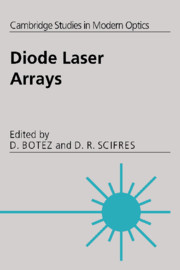Book contents
- Frontmatter
- Contents
- List of contributors
- Preface
- 1 Monolithic phase-locked semiconductor laser arrays
- 2 High-power coherent, semiconductor laser, master oscillator power amplifiers and amplifier arrays
- 3 Microoptical components applied to incoherent and coherent laser arrays
- 4 Modeling of diode laser arrays
- 5 Dynamics of coherent semiconductor laser arrays
- 6 High-average-power semiconductor laser arrays and laser array packaging with an emphasis on pumping solid state lasers
- 7 High-power diode laser arrays and their reliability
- 8 Strained layer quantum well heterostructure laser arrays
- 9 Vertical cavity surface-emitting laser arrays
- 10 Individually addressed arrays of diode lasers
- Index
6 - High-average-power semiconductor laser arrays and laser array packaging with an emphasis on pumping solid state lasers
Published online by Cambridge University Press: 10 November 2009
- Frontmatter
- Contents
- List of contributors
- Preface
- 1 Monolithic phase-locked semiconductor laser arrays
- 2 High-power coherent, semiconductor laser, master oscillator power amplifiers and amplifier arrays
- 3 Microoptical components applied to incoherent and coherent laser arrays
- 4 Modeling of diode laser arrays
- 5 Dynamics of coherent semiconductor laser arrays
- 6 High-average-power semiconductor laser arrays and laser array packaging with an emphasis on pumping solid state lasers
- 7 High-power diode laser arrays and their reliability
- 8 Strained layer quantum well heterostructure laser arrays
- 9 Vertical cavity surface-emitting laser arrays
- 10 Individually addressed arrays of diode lasers
- Index
Summary
Introduction
In recent years there has been an evolution in interest in semiconductor laser technology from exploring the performance limits of single devices of inherently low power to exploiting the potential of large arrays of devices of much higher power. While the low-power semiconductor devices are a proven component in many commercial systems, it is clear that a number of applications also exist for high-power arrays and that semiconductor-laser researchers are now poised to tackle them.
The manufacture of large volumes of semiconductor laser arrays with high yield has enabled the fabrication of larger and larger arrays. Rather than mounting single devices on copper submounts, and thus limiting the modest amount of steady state waste heat which can be dissipated, the laser designer is now faced with the challenging task of fabricating increasing numbers of devices in increasingly smaller volumes and operating these units at increased duty cycle or average power. We are faced with the same evolution of technology which IC chip manufacturers have faced for years; however, the semiconductor lasers are far more temperature sensitive than silicon-based electronic circuits and the task is ever more challenging.
Depending on the application, the utility of any laser is governed by its ability to deliver photons to a remote location, which in turn depends on the beam quality.
- Type
- Chapter
- Information
- Diode Laser Arrays , pp. 255 - 293Publisher: Cambridge University PressPrint publication year: 1994
- 3
- Cited by



